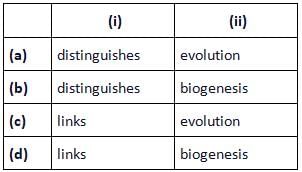Test: Populations & their Interactions - NEET MCQ
30 Questions MCQ Test Biology Class 12 - Test: Populations & their Interactions
The density of a population in a given habitat during a given period, fluctuates due to changes in certain basic processes. On this basis, fill up boxes A and B in the given flow chart with correct option.


What does the shape of the given age pyramids reflects about the growth status of the related population?


| 1 Crore+ students have signed up on EduRev. Have you? Download the App |
The population growth is generally described by the following equation:

What does 'r' represent in the given equation?

What does 'r' represent in the given equation?
The plant-animal interactions often involve co-evolution of the mutualists so that
An association between roots of higher plants and fungi is called
Species interaction with negative influence on both is referred to as
In a pond, last year there were 30 lotus plants. Through reproduction, 25 new lotus plants were added in one year while 8 plants died. The birth and death rates for the lotus population respectively are ___ and ____ individuals per lotus per year.
Which of the following is not an example of using relative density to measure population density in a certain area?
Total number of individuals of a species per unit area and per unit time is called:
Percentage of individuals of a given age group in a given population is called as
Population ecology is an important area because it _____(i)_______ ecology to population genetics and _____(ii)________
identify (i) and (ii) in the above statement and select the correct option.

In a given population of 2000 individuals, 80 births and 125 deaths were reported over a given period of time. Which of the following graphs will correspond to it?
Parameters related to age structure include
The age structures of a population influences population growth because
Which of the following factors has a negative effect on the population growth rate?
If N population density at time t, then population density at time t+1 can be written as
Nt +1=Nt +[(A+B)−(C+D)]
Select the correct option for A, B, C and D in the above equation.
Which of the following is not a factor that would limit the growth of a population?
The given figure represents different factors affecting population density (N) If B = nasality, D = mortality, E = emigration and I = immigration; then select the incorrect option regarding these.

Exponential growth is observed in a population when
In a population per capita birth rate is 0.15 and per capita death rate is 0.08 during a unit time period. What is the value of r (intrinsic rate of natural increase) for the given population?
The maximum possible number of individuals that a habitat can support is called its
Which of the following equations correctly represents verhulst-Pearl logistic growth?
Study the population growth curves (A and B) in the given graph and select the incorrect option

A population with a larger proportion of older individuals than younger ones will likely to
In a life table, the number of individuals alive at the beginning of the 1 st year to 2 nd year interval is 800. During this interval, 200 individuals die. The death rate for this interval is
Which type of interaction is being shown in the given figure?

Obligate parasites are those organisms which
The interdependent evolution of flowering plants and pollinating insects together is known as
When two similar species live in the same area, they may evolve to become more different in order to ________________.
Do humans exhibit any mutualistic relationships?
|
78 videos|276 docs|174 tests
|























